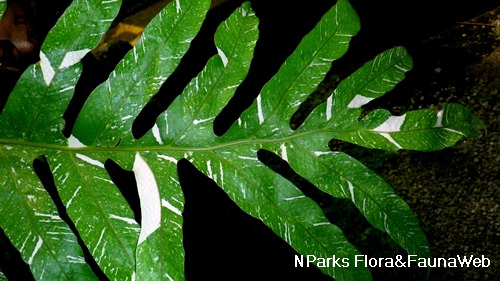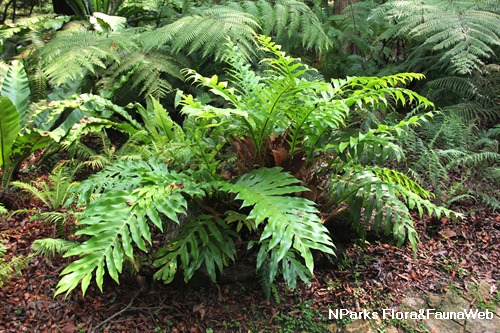.jpg)
Back
Drynaria rigidula (Sw.) Bedd.
| Family Name: | Polypodiaceae |
| Synonyms: | Aglaomorpha rigidula (Sw.) Hovenkamp & S.Linds., Polypodium rigidulum Sw. |
| Common Name: | Basket Fern, Oak Leaf Fern, Bird's Nest Fern |
Drynaria rigidula or Basket Fern is an epiphytic fern that can grow 1.5 m long. It produces 2 types of fronds; nest fronds and foliage fronds. The nest frond is oak-like, brownish red while the foliage frond is made up of linear leaflets held on a long stalk up to 40 cm long. The Basket Fern can be mounted or grown in a basket with good drainage soil mix and high organic matter.
Name
Classifications and Characteristics
| Plant Division | Ferns & Lycophytes (Non-Seed Vascular Plants) (Fern) |
|---|---|
| Plant Growth Form | Herbaceous Plant |
| Maximum Height | 1.5 m |
Biogeography
| Native Distribution | Southeast Asia to Pacific Islands, Australia |
|---|---|
| Native Habitat | Terrestrial |
| Preferred Climate Zone | Tropical |
| Local Conservation Status | Non-native |
Description and Ethnobotany
| Growth Form | It is an epiphytic fern that can reach up to 1.5 long, with stout creeping rhizomes covered in dense brown to dark brown hairs. |
|---|---|
| Foliage | There are two type of foliage; nest fronds (sterile) and foliage fronds (fertile). Nest fronds are oak-like, stalkless, brownish red in colour with denticulate margins. They have a papery texture and tend to overlap one another, measuring between 10 - 30 cm long and 5 - 15 cm wide. Foliage fronds are pinnate, green, sometimes erect. They can reach between 25 - 200 cm long, made up of linear leaflets with crenate to serrate margins. Each frond is held on a brownish red to purple stipe with short fine hairs measuring up to 40 cm long. |
| Others - Plant Morphology | The sori are arranged in pairs on both sides of the midrib. The round sori (1 - 2 mm wide) are sunken into the foliage, which creates buldges on the upper surface of the foliage. |
| Habitat | Epiphytic, occasionally terrestrial. Occurs in various types of primary and secondary forest, savannah and plantations, wayside trees from sea level to altitude 2400m. Also epilithic, on lava or limestone. |
| Cultivation | As an epiphyte, it can be tied or mounted on a fern tree bark or grown in a basket that has good drainage soil mix with high organic matter content. Feed it with weak liquid fertilisers routinely. |
Landscaping Features
| Desirable Plant Features | Ornamental Foliage |
|---|
Plant Care and Propagation
| Light Preference | Semi-Shade |
|---|---|
| Water Preference | Moderate Water |
| Plant Growth Rate | Fast to Moderate |
| Rootzone Tolerance | Well-Drained Soils |
| Propagation Method | Spore |
Foliar
| Mature Foliage Colour(s) | Green, Brown |
|---|---|
| Foliar Type | Simple / Unifoliate |
| Foliar Arrangement Along Stem | Basal |
| Foliar Attachment to Stem | Petiolate |
| Foliar Shape(s) | |
| Foliar Margin | Crenate, Denticulate, Serrate / Toothed |
| Foliar Apex - Tip | Acuminate |
| Foliar Base | Cuneate |
Non - Foliar and Storage
| Stem Type & Modification | Acaulescent |
|---|---|
| Root Type | Underground (Fibrous Root) |
| Specialised Storage Organ(s) | Underground (Rhizome) |
References
| References | Hovenkamp, P.H. (1998). Polypodiaceae. Flora Malesiana. ser. 2, Pteridophyta, 3(1). Leiden: Naturalis Biodiversity Center Royal Botanic Gardens, Kew (continuously updated). Plants of the World Online | Kew Science. https://powo.science.kew.org/taxon/urn:lsid:ipni.org:names:17091820-1. Accessed 13 January 2022. |
|---|
Image Repository
Others
| Master ID | 34237 |
|---|---|
| Species ID | 8650 |
| Flora Disclaimer | The information in this website has been compiled from reliable sources, such as reference works on medicinal plants. It is not a substitute for medical advice or treatment and NParks does not purport to provide any medical advice. Readers should always consult his/her physician before using or consuming a plant for medicinal purposes. |

.jpg)
.jpg)
.jpg)

